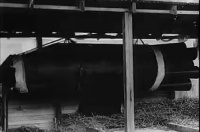Robert Condit and his Rocket to Venus by Ron Miller
From The Space Library
The prehistory of spaceflight is filled with mad scientists. Some of their work led directly to the development of space exploration...others had a much weirder destiny. Such was the case with Robert Condit, who built a rocket in 1928 that he planned to fly from Baltimore to Venus.
Condit's spaceship was a 24-foot-long bullet made of angle iron and sailcloth. It was constructed with the aid of brothers Harry B. and Sterling Uhler of Baltimore—-where the launch was to take place.
Apparently Condit, described as a "Miami chemist", had built an earlier rocket in his home state. His goal had been Venus then, as well (the rocket was to have been guided to the planet by "polarized magnetic controls").
The Baltimore rocket was fueled with 50 gallons of gasoline with eight steel pipes for engines. The several layers of sailcloth that covered the rocket were impregnated with varnish making an airtight shell "as brittle as glass." The nose section unscrewed to allow the rocket's single passenger ingress. Inside was a large tank of oxygen, a supply of concentrated food tablets and water in 1.5-inch pipes that lined the interior to save space. There were also a "couple [of] flashlights and a first aid kit, and that was it." There were two glass portholes, though there was no way to steer the rocket. He planned to hit Venus by taking very careful aim at takeoff. In the nose was a 25-foot silk parachute that the pilot could push out in order for the rocket to make a safe descent.
Inside was an air compressor run by a gasoline motor. This sprayed vaporized fuel into the steel tubes. A spark plug in each, attached to a battery in the ship, kept the gasoline burning.
It was estimated by Condit (described by Harry as "a mathematical wizard") that if the ship could get off the ground and travel at 25,000 mph, it would "pull out of the earth's gravity about 40 miles up and coast right on over to Venus."
Modern Mechanix published this illustration of Condit and his rocket. The inset at the lower left is actually a diagram of the spaceship designed by Hermann Oberth.
The rocket took 8 months to build. It was fueled and set up on a sidewalk on Morling Avenue. Handsome, athletic-looking Condit crawled inside and started the engines. It was his plan to only take the rocket up a quarter of a mile or so "until he got the feel of her."
In the words of eyewitness Harry Uhler, "I never saw so much fire in my life."
The Venus rocket never left the ground, though it did succeed in drawing a substantial crowd, and probably an ambulance. The hopeful astronauts decided that what they needed was a booster and, as they figure that would cost them at least $10,000, they gave up the entire project. "Our wives were against the whole deal, anyway," lamented Harry. Condit returned later, loaded the rocket onto a truck and headed for Florida...where he disappears from history.
 Modern Mechanix published this illustration of Condit and his rocket. The inset at the lower left is actually a diagram of the spaceship designed by Hermann Oberth.
Modern Mechanix published this illustration of Condit and his rocket. The inset at the lower left is actually a diagram of the spaceship designed by Hermann Oberth.
Today, a Baltimore restaurant commemorates the great event.


